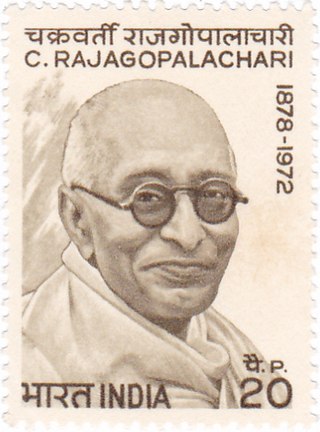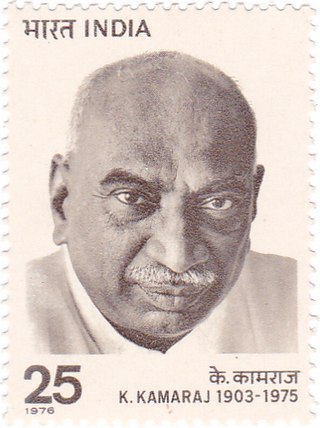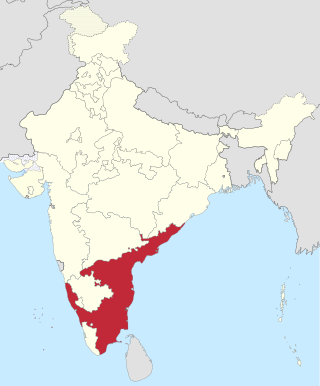Related Research Articles

Chakravarti Rajagopalachari BR, popularly known as Rajaji or C.R., also known as Mootharignar Rajaji, was an Indian statesman, writer, lawyer, and independence activist. Rajagopalachari was the last Governor-General of India, as when India became a republic in 1950 the office was abolished. He was also the only Indian-born Governor-General, as all previous holders of the post were British nationals. He also served as leader of the Indian National Congress, Premier of the Madras Presidency, Governor of West Bengal, Minister for Home Affairs of the Indian Union and Chief Minister of Madras state. Rajagopalachari founded the Swatantra Party and was one of the first recipients of India's highest civilian award, the Bharat Ratna. He vehemently opposed the use of nuclear weapons and was a proponent of world peace and disarmament. During his lifetime, he also acquired the nickname 'Mango of Salem'.
Reddiar is a Telugu speaking land owning, merchants, agricultural social group in Tamil Nadu and Pondicherry.

Tamil Nadu Legislative Council was the upper house of the former bicameral legislature of the Indian state of Tamil Nadu. It began its existence as Madras Legislative Council, the first provincial legislature for Madras Presidency. It was initially created as an advisory body in 1861, by the British colonial government. It was established by the Indian Councils Act 1861, enacted in the British parliament in the aftermath of the Indian Rebellion of 1857. Its role and strength were later expanded by the second Council Act of 1892. Limited election was introduced in 1909. The Council became a unicameral legislative body in 1921 and eventually the upper chamber of a bicameral legislature in 1937. After India became independent in 1947, it continued to be the upper chamber of the legislature of Madras State, one of the successor states to the Madras Presidency. It was renamed as the Tamil Nadu Legislative Council when the state was renamed as Tamil Nadu in 1969. The Council was abolished by the M. G. Ramachandran administration on 1 November 1986. In 2010 the DMK regime headed by M. Karunanidhi tried to revive the Council. The former AIADMK regime (2016-2021) expressed its intention not to revive the council and passed a resolution in the Tamil Nadu Legislative Assembly in this regard.
The Modified Scheme of Elementary Education or New Scheme of Elementary Education or Madras Scheme of Elementary Education dubbed by its critics as Kula Kalvi Thittam, was an abortive attempt at education reform introduced by the Indian National Congress Government of the Madras State, led by C. Rajagopalachari (Rajaji) in 1953. The scheme proposed the introduction of two shifts or sessions in elementary schools. In one session regular teaching would be done and during the second session, the students would be sent home to learn the occupations of their parents. It became controversial and was accused of being a casteist scheme to perpetuate the caste hierarchy as Hindu Professions were caste based. Public opposition and internal dissent within the congress led to the deferment of the scheme. The discontent it triggered among the Congress legislature members forced the resignation of Rajaji as Chief Minister. The scheme was dropped completely by Rajaji's successor Kamaraj in 1954.
Politics of Tamil Nadu is the politics related to the Indian state of Tamil Nadu.

The fourth legislative assembly election of Madras State was held in February 1967. The Dravida Munnetra Kazhagam (DMK) led coalition under the leadership of C.N. Annadurai won the election defeating the Indian National Congress (Congress). Anti-Hindi agitations, the rising prices of essential commodities, and a shortage of rice were the dominant issues. K. Kamaraj's resignation as the Chief Minister in 1963, to concentrate on party affairs, along with persistent rumors of corruption had weakened the incumbent Congress Government. This was the second time after Communist Party of India winning Kerala assembly elections in 1957, for a non-Congress party to gain the majority in a state in India, and the last time that Congress held power in Tamil Nadu. It was the first time a party or pre-election alliance formed a non-Congress government with an absolute majority. It marked the beginning of Dravidian dominance in the politics of Tamil Nadu. Annadurai, who became the first non-Congress chief minister of post-independence Tamil Nadu, died in office in 1969 and V.R. Nedunchezhiyan took over as acting chief minister.
Shanmugha Rajeswara Sethupathi or Naganatha Sethupathi was an Indian politician of the Justice Party and later, the Indian National Congress and head of the zamindari of Ramnad or Ramnad kingdom from 1929 to 1967. He was a member of the Madras Legislative Assembly from 1951 to 1967 and served as a minister in C. Rajagopalachari and K. Kamaraj's cabinets. He was popular as the main political opponent of U. Muthuramalingam Thevar.
Udupi Krishna Rau was a medical practitioner and politician of the Indian National Congress. He served as mayor of Madras city and as State minister.

The first legislative assembly Election to the Madras state based on universal adult suffrage was held in March 1952. This was the first election held in Madras state after the Indian Independence. This election was officially known as the 1951 Madras State Election, even though through delays, actual voting didn't take place until early 1952.

The second legislative assembly election to the Madras state was held on 31 March 1957. This was the first election held after the linguistic reorganisation of Madras State in 1956. Indian National Congress and its leader, K. Kamaraj won the election and defeated their rival, Dravida Munnetra Kazhagam. In 1954, due to the resignation of C. Rajagopalachari, for his controversial Kula Kalvi Thittam, the leadership of Congress was contested between K. Kamaraj, and C. Subramaniam. Eventually, K. Kamaraj, won the support of the party, was elected leader and chief minister of Madras State in 1954. In a surprise move, he appointed both M. Bhaktavatsalam and C. Subramaniam, to his cabinet, allowing great unity amongst the Congress that ruled the state of Madras, for the next decade. This election saw future DMK leaders M. Karunanidhi and K. Anbazhagan win their first MLA seats in the legislative assembly.

The third legislative assembly election to the Madras state was held on 21 February 1962. The Indian National Congress party, led by K. Kamaraj, won the election. Dravida Munnetra Kazhagam made significant in-roads in the election and emerged as the second party for the first time by winning 50 seats. 1962 Election remains the most recent election in which Indian National Congress to form a majority Government in the State as its support was heavily declined due to rise of Dravidian political parties.

The Tamil Nadu Legislative Assembly is the unicameral legislature of the Indian state of Tamil Nadu. It has a strength of 234 members, all of whom are democratically elected using the first-past-the-post system. The presiding officer of the Assembly is the Speaker. The term of the Assembly is five years, unless dissolved earlier.

The second legislative assembly election for the Madras Presidency after the establishment of a bicameral legislature by the Government of India Act of 1935 was held in 1946. The election was held after 6 years of Governor's rule starting from 1939, when the Indian National Congress government of C. Rajagopalachari resigned protesting Indian involvement in World War II. This was the last election held in the presidency - after Indian independence in 1947, the presidency became the Madras state. The election was held simultaneously with that of the Legislative Council. The Congress swept the polls by winning 163 out of 215 seats. The years after this election saw factionalism in Madras Congress party with divisions across regional and communal lines. Competition among T. Prakasam, C. Rajagopalachari and K. Kamaraj resulted in the election of Prakasam as the Chief Minister initially. But he was later defeated by Omandur Ramaswamy Reddiar with Kamaraj's support. In turn, Reddiar himself was ousted to make way for P. S. Kumaraswamy Raja with the support of Kamaraj.
C. Rajagopalachari was a Chief Minister of erstwhile Madras Presidency and Madras State of Independent India. He was the first Indian National Congress member to assume office in Madras Presidency. He served as a Chief Minister for two terms spanning about five years. He was elected as a Chief Minister after 1937 elections in Madras Presidency and served till 1939. He was also the Chief Minister of Madras State after first elections held after Indian independence. His second term lasted from 1952 till 1954.
The second legislative council election for the Madras Presidency after the establishment of a bicameral legislature by the Government of India Act of 1935 was held in March 1946. The election was held after 6 years of Governor's rule starting from 1939, when the Indian National Congress government of C. Rajagopalachari resigned protesting Indian involvement in World War II. This was the last direct election held for the Madras Legislative Council in the presidency - after Indian independence in 1947, the presidency became the Madras state and direct elections to the council were abolished. The election was held simultaneously with that of the Legislative Assembly. The Congress swept the polls by winning 32 out of 46 seats. The years after this election saw factionalism in Madras Congress party with divisions across regional and communal lines. Competition among T. Prakasam, C. Rajagopalachari and K. Kamaraj resulted in the election of Prakasam as the Chief Minister initially. But he was later defeated by Omandur Ramaswamy Reddiar with Kamaraj's support. In turn, Reddiar himself was ousted to make way for P. S. Kumaraswamy Raja with the support of Kamaraj.
Jothi Venkatachalam was an Indian politician who served as Governor of Kerala and Member of the Legislative Assembly of Tamil Nadu.

Madras State was a state of India during the mid-20th century. At the time of its formation in 1950, it included the whole of present-day Tamil Nadu, Coastal Andhra, Rayalaseema, the Malabar region of North and central Kerala, Bellary, South Canara and Kollegal. Coastal Andhra and Rayalaseema were separated to form Andhra State in 1953, while South Canara and Bellary districts along with the Kollegalam taluka of Coimbatore district were merged with Mysore State, and Malabar District with the State of Travancore-Cochin to form Kerala in 1956. Post State Reorganization in 1956, the remaining Madras State was renamed to Tamil Nadu on January 14, 1969.
Elections to the Andhra State Legislative Assembly were held on 11 February 1955. 581 candidates contested for the 167 constituencies in the Assembly. There were 29 two-member constituencies and 138 single-member constituencies. The members of the first assembly (1955–62) were allowed a seven-year term. That is to say, in 1957, elections were conducted in the newly added region of Telangana alone, and then in 1962, general elections were held for the state as a whole.

K. Kamaraj was sworn in as the Chief Minister of Madras State on 13 April 1954. K. Kamaraj ousted Rajaji on 31 March 1954 and was elected the leader of Congress Legislative Party. Kamaraj consolidated his position by offering ministerial position to leaders of Tamil Nadu Toilers Party and Commonweal Party. This event marked the end of Brahmin domination in Tamil Nadu Congress.
References
- ↑ "TAMIL NADU LEGISLATIVE ASSEMBLY" . Retrieved 22 December 2012.
- 1 2 "A Review of the Madras Legislative Assembly (1952-1957)" (PDF). MADRAS LEGISLATIVE ASSEMBLY. Retrieved 22 December 2012.
- ↑ "Leader, amend thy mind". Expressindia.com. 8 November 1997. Archived from the original on 24 September 2012. Retrieved 29 December 2012.
- ↑ "T V R Shenoy on another bout of uncertainty in Tamil Nadu". rediff.com. 22 August 2001. Retrieved 29 December 2012.
- ↑ "Complete biography of K. Kamaraj". Preservearticles.com. Retrieved 29 December 2012.
- 1 2 "A Review of the Madras Legislative Assembly (1952-1957) : Section II" (PDF). Tamil Nadu Legislative Assembly. Archived from the original (PDF) on 17 October 2013. Retrieved 29 December 2012.
- ↑ "A Review of the Madras Legislative Assembly (1952-1957) : Section I" (PDF). Tamil Nadu Legislative Assembly . Retrieved 11 February 2010.
- ↑ Justice Party golden jubilee souvenir, 1968. Justice Party. 1968. p. 58. ISBN.